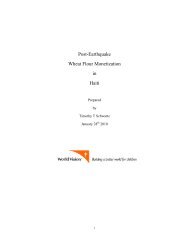BARR_Report_Ravine_Pentad_Final_v_31
Create successful ePaper yourself
Turn your PDF publications into a flip-book with our unique Google optimized e-Paper software.
3.4 Current Occupancy Rates<br />
<strong>BARR</strong> found that despite the destruction most people had returned to their homes. Figure 29<br />
shows the total population of <strong>Ravine</strong> <strong>Pentad</strong> before versus after the Earthquake, 4,421 versus<br />
3,666; Figure 30 shows the same population comparison for the <strong>BARR</strong> Port-au-Prince sample.<br />
Figure <strong>31</strong> shows what these changes indicate: at 16% and 17% the January 2010 to January<br />
2011 population reduction for <strong>Ravine</strong> <strong>Pentad</strong> is nearly identical to that of Port-au-Prince. When<br />
the population killed is subtracted from the total proportion of absentees, as in Figures 32, the<br />
figures for <strong>Ravine</strong> <strong>Pentad</strong> versus greater Port-au-Prince are even closer, 13.4% versus 13.9%.<br />
In the final chart below, Figure 33, it can be seen that the absentees per household color code<br />
are nearly identical in every case but Red houses. One possible explanation for the difference is<br />
that CHF has conducted demolition activities in <strong>Ravine</strong> <strong>Pentad</strong>.<br />
Figure 29: Population of <strong>Ravine</strong> <strong>Pentad</strong><br />
Before vs After the Earthquake<br />
Figure 30: Population of P-au-P<br />
Before vs After the Earthquake<br />
Figure <strong>31</strong>: Proportion of Residents Absent<br />
<strong>Ravine</strong> <strong>Pentad</strong> vs PauP<br />
Figure 32: Absentees Less those Killed<br />
<strong>Ravine</strong> <strong>Pentad</strong> vs PauP<br />
Figure 33: Occupants per Color Coded House Category<br />
13
















